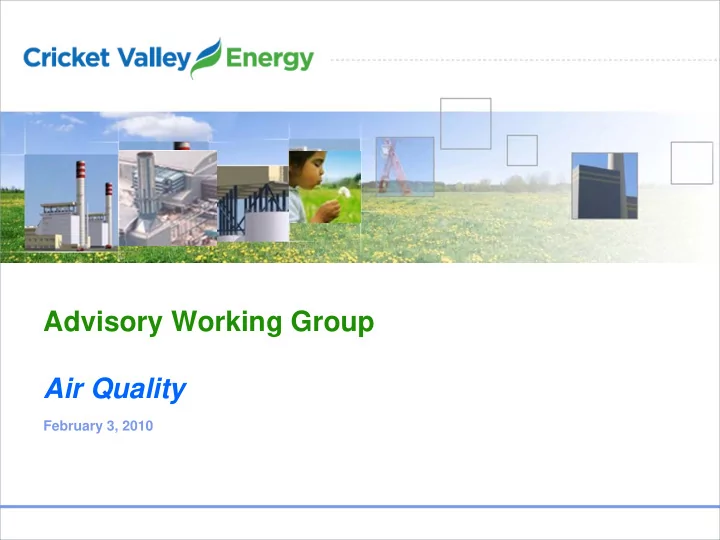

Advisory Working Group Air Quality February 3, 2010
Agenda � Introductions � About Advisory Groups � Project Review � Air Quality Discussion � Q&A � Next Meeting
What is an Advisory Working Group? � 3 Advisory Working Groups (AWGs) � Air Quality � Safety and Traffic � Water, Wetlands and Wildlife � Small, hands on groups with representatives from public, private and nonprofit sectors � Forum for exchange of information, discussion of issues, solicitation of feedback the study team will take into consideration � Supplemental to formal study process—AWG is not an official part of the SEQR process
What is Expected of AWG Members? � Attending working group sessions � No specialized knowledge needed—technical information will be presented in layman terms � Interest and commitment to participate—Speak Up � If you represent an organization, keep it informed of AWG information, and give us feedback � Members can serve on one, two or all three groups
Meetings � Workshop-style sessions to explore technical details of the project � Project team representatives will support discussions � Each group is a work in progress � Meetings will be held as needed or every 4-6 weeks � Overlap between topics is expected
Project Overview Features Site Map � 1,000 Megawatts (MW) � Combined-Cycle Technology � Next to Power Lines � Next to Natural Gas Pipeline � Industrially Zoned � Tree Buffer � Hill Buffer � Previously Developed Site
Project Schedule Recent Events � Nov 2009 – SEQR Initiated w/ Special Permit Application � Dec 2009 – Open House at Community Outreach Office � Jan 2010 – Wetlands Application Submitted � Feb 2010 – Advisory Working Groups Air Quality: Feb 3 rd Safety & Traffic: Feb 9 th Water, Wildlife, & Wetlands: Feb 17 th � March 2010 – Lead Agency Determination � April 2010 – SEQR Scoping Hearing
Air Quality Fred Sellars - ARCADIS Experience Qualifications
Air Quality Standards � Health-based ambient air quality standards , set by USEPA/NYSDEC to protect the most sensitive people: � Ozone � Particulate Matter – PM � Sulfur Dioxide – SO 2 � Nitrogen Dioxide – NO 2 � Carbon Monoxide – CO � Lead � Air toxics guideline concentrations based on each proposed source’s contribution to air quality – set by NYSDOH based on risk levels
How Clean is our Air? SO 2 (µg/m 3 ) PM 10 and PM 2.5 (µg/m 3 ) Background NAAQS Background NAAQS 1300 150 365 39 35 26 15 80 9.5 48.1 28 5.7 3-Hour 24-Hour Annual 24-Hour (PM10) 24-Hour (PM2.5) Annual (PM2.5) Averaging Period Averaging Period NO 2 (µg/m 3 ) CO (µg/m 3 ) Background NAAQS Background NAAQS 100 40000 23 10000 1650 1200 Annual 1-Hour 8-Hour Averaging Period Averaging Period
Air Quality Permitting � USEPA/NYSDEC permitting programs � Nonattainment New Source Review – for “non-attainment” pollutants (ozone) � Prevention of Significant Deterioration (PSD) Review – for “attainment” pollutants (all others) � Dutchess County is in attainment of all ambient air quality standards except ozone � Most of the Northeast U.S. is designated as non-attainment for ozone
Air Quality Protection Demonstrations Required � Emissions are controlled with the Best Available Control Technology (BACT)/Lowest Achievable Emission Rate (LAER) Technology � Emissions offsets are required for nonattainment pollutants (ozone precursors – NO x , VOC) � Air quality impacts cannot cause or significantly contribute to a violation of the air quality standards, taking into account existing air quality, contributions from our project and cumulative impacts from other major sources � For pollutants with project impacts below Significant Impact Levels (SILs) – no further analysis � For pollutants with project impacts above SILs – cumulative modeling with other major sources
Air Quality Focus Areas � Compliance with air toxics guideline concentrations � Additional impacts � Environmental Justice � Vegetation and soils � Visibility � Acid rain � Air Quality Related Values in designated “pristine” areas � Greenhouse gases � Accidental release consequence analysis
Project Features � Clean burning natural gas only � Same products of combustion as your furnace or stove � State-of-the-art emissions controls � Selective catalytic reduction � Oxidation catalyst � Good Engineering Practice stack height to minimize air quality impacts � Emissions will be monitored continuously (CEMs) and reported to NYSDEC
Approach to Air Quality Study � Detailed Modeling Protocol approved by USEPA and NYSDEC � Selection/approval of meteorological data for modeling � Receptor grid set to capture highest impacts and ensure sensitive receptors are included � Worst-case emission levels conservatively assumed � Short-term and long-term impacts compared to SILs � Cumulative impacts (for pollutants with impacts above SILs) to ensure compliance with all standards and guidelines
Questions & Contacts Matthew Martin, Associate Project Manager 845-877-0596, mmartin@advancedpowerna.com 5 Market Street, Dover, NY 12522 Bob De Meyere, Project Manager 617-456-2214, bdemeyere@advancedpowerna.com 31 Milk Street, Suite 1001, Boston, MA 02109
Recommend
More recommend